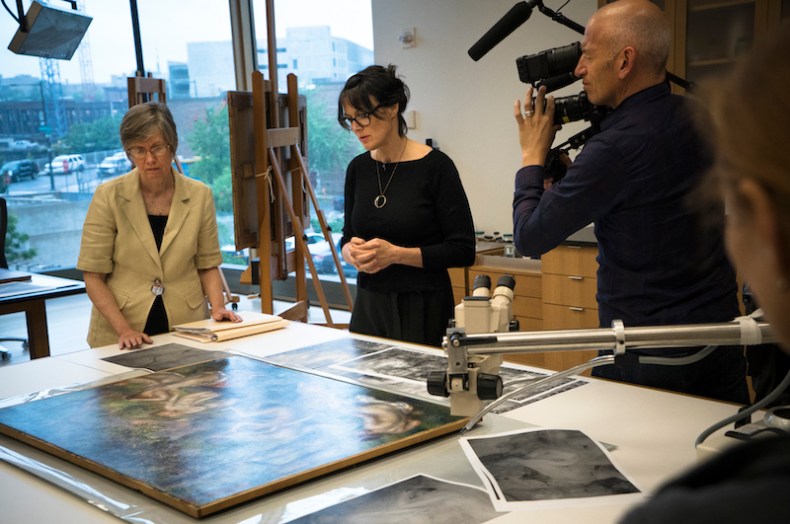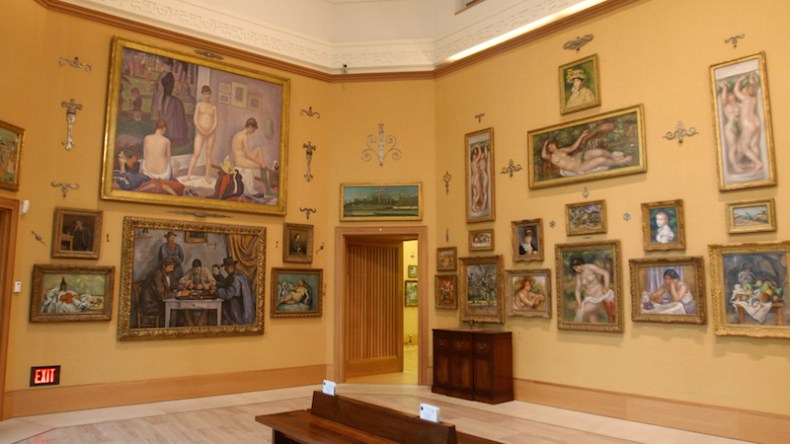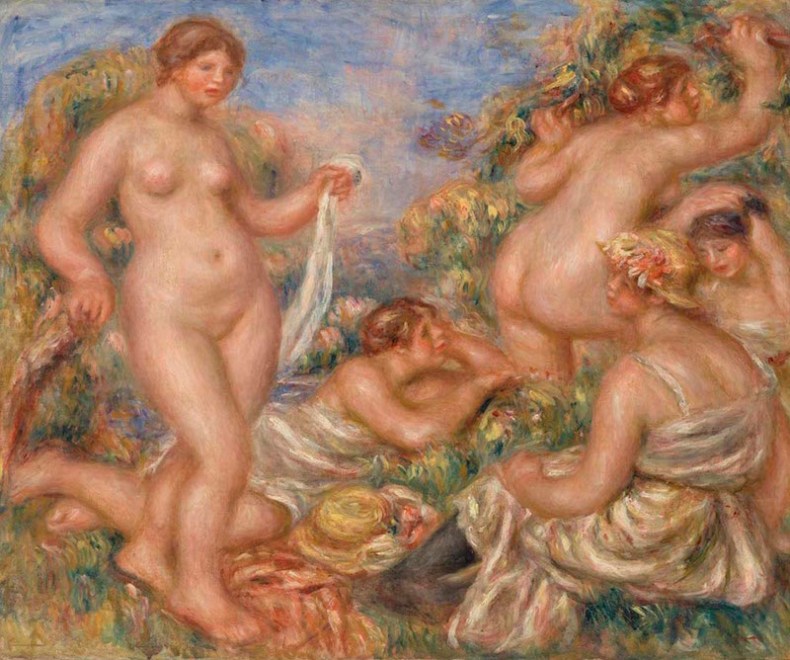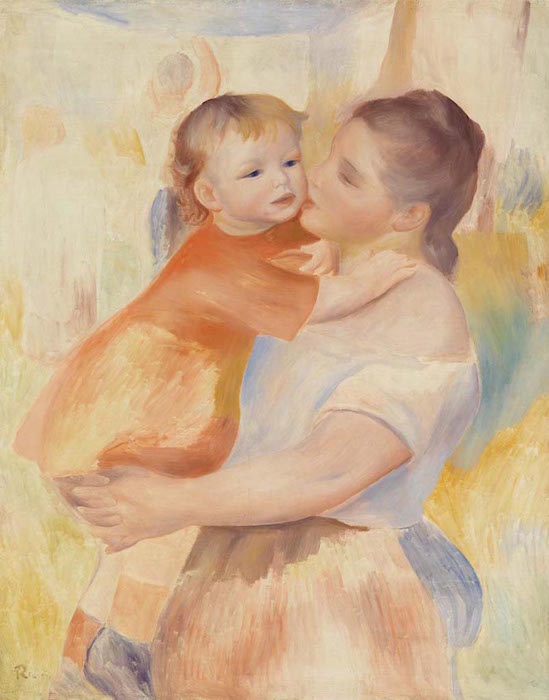Living in the age of the online petition can be edifying – I’ve signed a couple without the hubris of expecting them to affect change – and hilariously annoying. Take the #RenoirSucksAtPainting grassroots movement, in which members encourage galleries to take down the artist’s paintings by posting selfies on social media in front of them while flicking the V sign, making themselves gag or holding up placards (‘God Hates Renoir’ is a favourite). As a collection of images on Instagram it’s a joyful project, the cloying sweetness of the past coming up against the cute teenage iconoclasm of today. As an actual protest (and yes, the movement has picketed museums in America that aren’t even mounting big Renoir shows) it’s empty audacity. Yet, unlike most movements of its type, it seems also to represent the establishment’s view.
‘We don’t really think that much about Renoir unless we have to,’ says the New York Times’s Ken Johnson as a talking head in Renoir: Revered and Reviled, a film about The Barnes Foundation in Philadelphia, which owns the largest collection of Renoirs in the world (181 works). Johnson speaks, it seems, on behalf of critics as a whole.
On the one hand Pierre-Auguste Renoir is no longer considered an artists’ artist, either lighter than his Impressionist contemporaries or ideologically problematic: a misogynist who ceased to think of the female figures he depicted as having any inner life. On the other we cannot deny that he has been an artists’ artist: loved above all by Picasso and Matisse. Renoir encouraged these artists to reimagine how a three-dimensional human shape could appear on a flat canvas (this encouragement was literal in the case of Matisse, who often took his work to be appraised by the older master). He also appeals to a public not bogged down by art theory. It was in this way that he became the obsession of Dr. Albert C. Barnes, a wealthy Pennsylvanian chemist who dedicated his life to collecting the artist; he established strong ties with Renoir’s most trusted dealer Paul Durand-Ruel (approximately 1,500 of the artist’s canvasses passed through Durand-Ruel’s hands).

Still from Renoir: Revered and Reviled, Martha Lucy and Barbara Buckley at The Barnes Foundation. © EXHIBITION ON SCREEN
More importantly, Renoir drove Barnes to try to understand art: an understanding that Seventh Art Productions, who have made previous Exhibition On Screen documentaries about famous permanent collections and major exhibitions – such as Goya: Visions of Flesh and Blood – let us glimpse from the inside. There ought to be a similar film for every gallery in the world, enabling access for people who would never get to visit them otherwise.

Still from Renoir: Revered and Reviled, View of Renoir wall. © EXHIBITION ON SCREEN
The film reveals the idiosyncratic way Barnes left his collection hung upon his death in 1951 – a clause in his will makes it impossible for the arrangement to be disassembled – and leaves you to puzzle Barnes’ logic. The walls are covered almost completely, not only with paintings, but with clocks, miscellaneous sconces and antique door knockers. Against the walls there are chairs and desks piled with sculptures, candlestick holders, vases (five by the artist’s son and biographer, the filmmaker Jean Renoir), and metal teapots. Small Renoirs and other Post-Impressionist works are grouped, for instance, around a larger Frans Hals. (Other highlights, just for the pleasure of listing them, include a selection of Cezanne’s still lifes and bathers, as well as his famous masterpiece The Card Players [1890–92], and excellent reclining nudes by Modigliani and Matisse). Seeing the Barnes on film makes you realise the uncluttered sterility of most major galleries.

Composition, Five Bathers, 1918, Pierre-Auguste Renoir. © 2012 The Barnes Foundation
And there’s a quality to the arrangement of the pieces that settles the Renoirs on show. Barnes preferred what are today considered Renoir’s more unpopular works, even by Renoir’s standards: works after he left the safety and legitimacy of the Impressionist bracket (if you can ever say he truly left it) and embarked on the succession of later styles that made up his mature period from the mid 1880s to his death in 1919.

Washerwoman and Child, 1886, Pierre-Auguste Renoir. © 2012 The Barnes Foundation
Washerwoman and Child of 1886 emerged following a trip to study Renaissance artists in Italy. It is unlike anything else Renoir produced, with a bright matte quality found in the work of 15th-century Florentine School painters, but also gesturing towards the edgeless faces in his later work that people now find difficult to appreciate. Then there is the artist’s four-year labour of love, Large Bathers (1884–87), in which solid Titianesque nudes stand out from an Impressionist brook scene, the brushwork visible.
Yet the much later unchallenging portraits of women somehow look more important next to the painter’s earlier women. In The Dancer (1874), we see the moment where the reserve of the young sitter meets the assurance and stature of the dancer. In Before the Bath (1875) the subject displays the polite awkwardness of wanting the viewer to leave her alone. Indeed, many of the critics in the film who see Renoir’s later nudes as ‘negligible’ or lightweight leave their interviews persuaded to see something more in works from this problematic era.
There is also a case to be made that these later nudes, even if their charms are mainly decorative, don’t suffer because of this in the medium of film. Here we can appreciate the pure effects of technique blown up, the details of works becoming larger than the ambiguous pictures that contain them. If you can’t see art in the gallery itself, the cinema is the second best place to see it.
Renoir: Revered and Reviled was released in the UK on 16 February; it goes on international release from 15 March.

Does Renoir really suck at painting?
Photo: via @renoir_sucks_at_painting Instagram
Share
Living in the age of the online petition can be edifying – I’ve signed a couple without the hubris of expecting them to affect change – and hilariously annoying. Take the #RenoirSucksAtPainting grassroots movement, in which members encourage galleries to take down the artist’s paintings by posting selfies on social media in front of them while flicking the V sign, making themselves gag or holding up placards (‘God Hates Renoir’ is a favourite). As a collection of images on Instagram it’s a joyful project, the cloying sweetness of the past coming up against the cute teenage iconoclasm of today. As an actual protest (and yes, the movement has picketed museums in America that aren’t even mounting big Renoir shows) it’s empty audacity. Yet, unlike most movements of its type, it seems also to represent the establishment’s view.
‘We don’t really think that much about Renoir unless we have to,’ says the New York Times’s Ken Johnson as a talking head in Renoir: Revered and Reviled, a film about The Barnes Foundation in Philadelphia, which owns the largest collection of Renoirs in the world (181 works). Johnson speaks, it seems, on behalf of critics as a whole.
On the one hand Pierre-Auguste Renoir is no longer considered an artists’ artist, either lighter than his Impressionist contemporaries or ideologically problematic: a misogynist who ceased to think of the female figures he depicted as having any inner life. On the other we cannot deny that he has been an artists’ artist: loved above all by Picasso and Matisse. Renoir encouraged these artists to reimagine how a three-dimensional human shape could appear on a flat canvas (this encouragement was literal in the case of Matisse, who often took his work to be appraised by the older master). He also appeals to a public not bogged down by art theory. It was in this way that he became the obsession of Dr. Albert C. Barnes, a wealthy Pennsylvanian chemist who dedicated his life to collecting the artist; he established strong ties with Renoir’s most trusted dealer Paul Durand-Ruel (approximately 1,500 of the artist’s canvasses passed through Durand-Ruel’s hands).
Still from Renoir: Revered and Reviled, Martha Lucy and Barbara Buckley at The Barnes Foundation. © EXHIBITION ON SCREEN
More importantly, Renoir drove Barnes to try to understand art: an understanding that Seventh Art Productions, who have made previous Exhibition On Screen documentaries about famous permanent collections and major exhibitions – such as Goya: Visions of Flesh and Blood – let us glimpse from the inside. There ought to be a similar film for every gallery in the world, enabling access for people who would never get to visit them otherwise.
Still from Renoir: Revered and Reviled, View of Renoir wall. © EXHIBITION ON SCREEN
The film reveals the idiosyncratic way Barnes left his collection hung upon his death in 1951 – a clause in his will makes it impossible for the arrangement to be disassembled – and leaves you to puzzle Barnes’ logic. The walls are covered almost completely, not only with paintings, but with clocks, miscellaneous sconces and antique door knockers. Against the walls there are chairs and desks piled with sculptures, candlestick holders, vases (five by the artist’s son and biographer, the filmmaker Jean Renoir), and metal teapots. Small Renoirs and other Post-Impressionist works are grouped, for instance, around a larger Frans Hals. (Other highlights, just for the pleasure of listing them, include a selection of Cezanne’s still lifes and bathers, as well as his famous masterpiece The Card Players [1890–92], and excellent reclining nudes by Modigliani and Matisse). Seeing the Barnes on film makes you realise the uncluttered sterility of most major galleries.
Composition, Five Bathers, 1918, Pierre-Auguste Renoir. © 2012 The Barnes Foundation
And there’s a quality to the arrangement of the pieces that settles the Renoirs on show. Barnes preferred what are today considered Renoir’s more unpopular works, even by Renoir’s standards: works after he left the safety and legitimacy of the Impressionist bracket (if you can ever say he truly left it) and embarked on the succession of later styles that made up his mature period from the mid 1880s to his death in 1919.
Washerwoman and Child, 1886, Pierre-Auguste Renoir. © 2012 The Barnes Foundation
Washerwoman and Child of 1886 emerged following a trip to study Renaissance artists in Italy. It is unlike anything else Renoir produced, with a bright matte quality found in the work of 15th-century Florentine School painters, but also gesturing towards the edgeless faces in his later work that people now find difficult to appreciate. Then there is the artist’s four-year labour of love, Large Bathers (1884–87), in which solid Titianesque nudes stand out from an Impressionist brook scene, the brushwork visible.
Yet the much later unchallenging portraits of women somehow look more important next to the painter’s earlier women. In The Dancer (1874), we see the moment where the reserve of the young sitter meets the assurance and stature of the dancer. In Before the Bath (1875) the subject displays the polite awkwardness of wanting the viewer to leave her alone. Indeed, many of the critics in the film who see Renoir’s later nudes as ‘negligible’ or lightweight leave their interviews persuaded to see something more in works from this problematic era.
There is also a case to be made that these later nudes, even if their charms are mainly decorative, don’t suffer because of this in the medium of film. Here we can appreciate the pure effects of technique blown up, the details of works becoming larger than the ambiguous pictures that contain them. If you can’t see art in the gallery itself, the cinema is the second best place to see it.
Renoir: Revered and Reviled was released in the UK on 16 February; it goes on international release from 15 March.
Unlimited access from just $16 every 3 months
Subscribe to get unlimited and exclusive access to the top art stories, interviews and exhibition reviews.
Share
Recommended for you
Affordable Art
A new 50p piece, designed by Tom Phillips to celebrate the centenary of Benjamin Britten’s birth, attempts to ‘set the wild echoes flying’
Looking for meaning: a conversation with Jonas Burgert
To me, Burgert’s paintings are packed with art-historical allusions. But if the artist meant them to sneak in, he won’t admit it
Egyptology from the point of view of Egyptians
Review of a groundbreaking study of overlooked 20th-century scholars